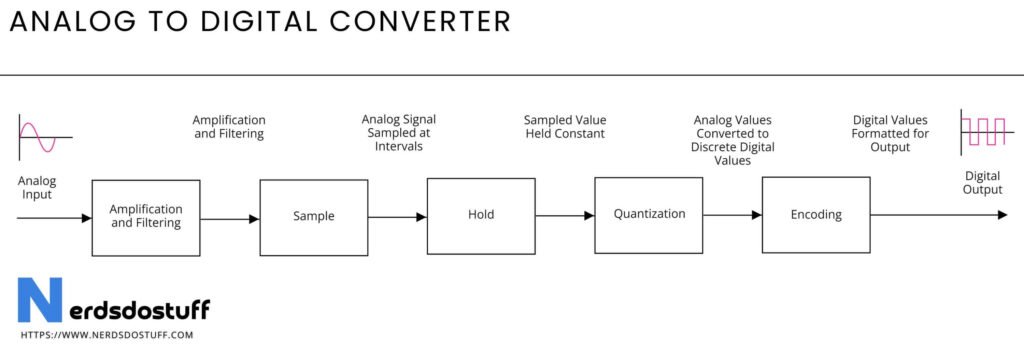What is Analog to Digital Converter ?
An analog to digital converter (ADC) is an electronic device that converts an analog signal, which is continuous in both time and amplitude, into a digital signal, which is discrete in both time and amplitude. This process involves sampling the analog signal at regular intervals (known as the sampling rate) and then quantizing each sample to the nearest value within a finite set of possible digital values. The result is a sequence of digital numbers that can represent the original analog signal with varying degrees of accuracy, depending on the resolution and sampling rate of the ADC.
The resolution of an ADC is typically expressed in bits and determines how many discrete levels the converter can output. For instance, an 8-bit ADC can represent an analog signal in 256 discrete levels (2^8), while a 16-bit ADC offers 65,536 levels (2^16), allowing for much finer granularity and more precise representation of the analog signal. The accuracy of the ADC also depends on the sampling rate, which is how frequently the analog signal is sampled per second. According to the Nyquist theorem, to accurately reconstruct the original analog signal, the sampling rate must be at least twice the highest frequency present in the signal. ADCs are integral components in various applications such as digital audio recording, medical imaging, and instrumentation where accurate digital representation of analog signals is crucial for processing, analysis, and storage.
Analog to Digital Converter Block Diagram

ADC Block Diagram Explained
- Analog Input Signal: This block represents the continuous analog signal that needs to be converted into a digital format. This signal could originate from various sources such as sensors, transducers, or audio equipment.
- Amplification and Filtering: In many cases, the analog signal needs to be amplified to ensure that its amplitude falls within the optimal range for conversion. Additionally, filtering may be employed to remove any unwanted noise or interference that could affect the accuracy of the conversion process. This block ensures that the signal is properly conditioned before being sampled.
- Sample and Hold (S/H): The sample and hold circuit captures and retains the amplitude of the analog signal at specific time intervals determined by the sampling rate. It samples the continuous analog signal at discrete points in time, holding each sampled value constant long enough for the subsequent stages of the ADC to process it. This ensures that each sample accurately represents the amplitude of the analog signal at a particular moment in time.
- Quantization: Quantization involves dividing the range of the analog signal into a finite number of discrete levels. This process assigns a digital value to each sampled analog value based on its magnitude. The resolution of the ADC, expressed in bits, determines the number of discrete levels available for quantization. Higher resolution ADCs can represent the analog signal with greater precision, resulting in a more faithful digital representation.
- Encoding: Once the analog signal has been quantized, the digital values are encoded into binary format for further processing or transmission. Each digital value represents the amplitude of the analog signal at a specific sampling instant. The encoding stage typically involves converting the quantized analog values into binary code, such as binary-coded decimal (BCD) or two’s complement representation, depending on the ADC’s architecture and application requirements.
- Digital Output Signal: Finally, the digital output signal consists of a stream of binary values that represent the sampled and quantized analog signal in digital form. This digital representation can be further processed, stored, or transmitted by digital systems such as microcontrollers, digital signal processors (DSPs), or computers for various applications such as data analysis, control, or communication.
Applications of Analog to Digital Converter
- Data Acquisition Systems: ADCs are extensively used in data acquisition systems for measuring and digitizing analog signals from sensors and transducers. These systems are employed in various fields such as industrial automation, environmental monitoring, and scientific research to collect real-world data for analysis and decision-making.
- Digital Audio Recording: In audio equipment, such as microphones, mixers, and audio interfaces, ADCs are crucial for converting analog audio signals into digital form for recording, editing, and playback. High-resolution ADCs ensure accurate capture of audio signals with minimal distortion, contributing to the production of high-fidelity audio recordings.
- Medical Imaging: ADCs play a vital role in medical imaging modalities such as X-ray, MRI (Magnetic Resonance Imaging), CT (Computed Tomography), and ultrasound. These devices utilize ADCs to convert analog signals generated by sensors or detectors into digital images for diagnostic purposes, enabling healthcare professionals to visualize internal anatomical structures and detect abnormalities.
- Wireless Communication: ADCs are essential components in wireless communication systems, including cellular networks, Wi-Fi, Bluetooth, and IoT (Internet of Things) devices. They digitize analog voice, video, and data signals into digital formats suitable for transmission over digital communication channels, facilitating reliable and efficient wireless communication.
- Instrumentation and Control Systems: In industrial automation, process control, and instrumentation systems, ADCs are used for monitoring and controlling physical variables such as temperature, pressure, flow, and voltage. By converting analog sensor signals into digital data, ADCs enable precise measurement, analysis, and control of industrial processes and equipment.
- Digital Signal Processing (DSP): ADCs are integral to DSP applications, where analog signals are processed, filtered, and manipulated digitally. ADCs capture analog signals from various sources, allowing DSP algorithms to perform tasks such as filtering, modulation, demodulation, compression, and encryption, enhancing the capabilities of audio, video, and communication systems.




